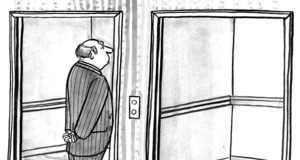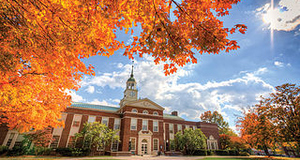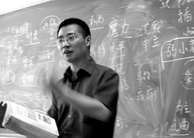Featured Article:Choosing a Dissertation Adviser: Challenges and Strategies for Doctoral Students
By
2017, Vol. 9 No. 03 | pg. 1/1
IN THIS ARTICLE
AbstractThe process of selecting a dissertation adviser can be accomplished in a number of ways. The importance, however, of this process should not be understated. This relationship between adviser and advisee often can be the difference between completing or not completing the dissertation. This research study looked at the selection process of a dissertation adviser from both a theoretical as well as practical perspective in a fast-track three-year doctoral leadership program at a medium size university in the United States.The methodological approach utilized a single focus group along with follow-up discussion with doctoral students. Recommendations are offered as to ways of addressing the problem or disconnect in the adviser selection process. IntroductionThe subject of selection of an adviser in a Ph.D. program has been examined as part of a variety of studies looking at doctoral education, with some of those studies concentrating on the role of the adviser (Barnes & Austin, 2009; Gardner, 2013; Jaeger, Sandman, & Kim, 2011; Joyce, 2016; Kim, 2007; Noy & Ray, 2012; Schlosser & Kahn, 2007) and other studies focusing on faculty members serving as mentors to doctoral students (Gearity &Mertz, 2012; Holley & Caldwell, 2012; Linden, Ohlin, & Brodin, 2013) and still other researchers looking to determine whether the title of adviser or mentor even matters when faculty support doctoral students (Brabazon, 2016; Titus & Ballou, 2011). This area of study lacks an extensive body of literature focusing on the subject of dissertation adviser selection, leaving open the question as to how doctoral candidates should best choose an adviser. Some researchers note that doctoral programs may vary, but central to all of them is the adviser-advisee role (Barnes & Austin, 2009; Gearity &Mertz, 2012; Martinsuo & Turkulainen, 2011). Killeya (2008) provided a variety of first considerations in choosing an adviser with most of these focusing more on the personal attributes of the person of choice. Adams and Ram (1992) also looked at the selection process and narrowed their focus to time, experience, research background, and again mainly personal attributes. This notion of the importance of personal attributes and interests of the adviser seemed consistent with some authors, but not with all, with Schlosser and Kahn (2007) finding, “factors other than interest agreement contribute to the quality and valence of the adviser alliance (p. 216).The focus of this paper is on examining what methods are used in the selection process and what might be the preferred method of choice for aspiring dissertation candidates. Hence, the research questions that this research seeks to answer are: Given that doctoral students in a fast-track, executive program in educational leadership are asked to select an adviser at the beginning of their second year of formal study, is this selection process flawed since most of these doctoral students appear to rely more on familiarity with members the doctoral faculty rather than more salient qualities of members the doctoral faculty? Also, can a framework be developed, supported by the literature, which can assist institutional development of a framework to assist in the successful pairing of doctoral students with supportive doctoral faculty? The importance of helping institutions refine this process is important, yet too often unrecognized when “fewer than half of faculty members report having policies or guides on advising doctoral students with only a quarter reporting having received any training in how to be an adviser” (Titus and Ballou, 2013, p. 1274). Although on the surface the process of pairing doctoral students with faculty may seem both simple and somewhat harmless, it can be a very difficult and challenging experience for a doctoral student. As noted by Sangganjanavanich and Magnuson (2009), “just as doctoral students often learn how to write a dissertation by writing a dissertation, they may learn about the long-term implications of adviser selection during or after the selection process” (p. 195). Both doctoral faculty and doctoral students are asked to develop a unique relationship based on what could be very different styles of managing research, providing feedback and communication, and developing trust and understanding. Other considerations might be faculty research agendas, background of experience, and assigned adviser roles. The increase in international doctoral students and the needs those students have adds additional variables, further complicating the process (Kim, 2016; Knox, Sokol, Schlosser, Inman, Nilsson, & Wang, 2013). This topic becomes increasingly important as new fast-track, three year executive programs continue to grow in higher education and as the traditional doctoral graduate student who teaches classes and is vested with the doctoral faculty has been replaced by the part-time doctoral student who holds a full-time position in the workforce. Part-time doctoral students have time and access-to-faculty restrictions that traditional doctoral programs of the past did not have, at least not to the extent of the fast-track doctoral programs of today (Murakami-Ramalho, Militello, & Piert, 2013). One of the authors of this study directs an executive-type fast-track doctoral program in management and leadership and has done so for over ten years. As part of this study the researchers will include some of the problems and concerns he and candidates in the program have experienced related to the selection process of advisers. Too often the adviser selection process becomes a quick and arbitrary way of assigning advisers while meeting contractual teaching assignments. Based on interviews with many of the candidates and a gap in the related literature, it is the intent of this study to illuminate this issue for those interested in the adviser selection process. Recommendations will be made based on the data that might offer ways to improve the adviser selection process. Review of Related ResearchThe importance of the dissertation adviser relationship is clearly recognized in the literature and can be summarized by Barbazon’s (2016) statement, “the most important decision a doctoral candidate makes is the selection of supervisor, because they can enable, assist, warn, frame and improve the topic” (p. 16). When discussing the development of doctoral students in Educational Administration programs, Murakami-Ramalho, Militello, and Piert (2013) go beyond the students effort during doctoral work as a determining factor of student success, concluding that “competence, confidence and capacity to understand and utilize research depended on the educational administration students’ focus on building technical skills as well as program and faculty support structures” (p.270). Holley and Caldwell (2012) further advance the importance of the institution’s responsibility in the success of doctoral student support adding, “the design and implementation of a successful doctoral mentoring program is dependent on several factors including … the administrative willingness to coordinate the initiative” (p.253). Stark (2013) held with the notion there is not a right or wrong way to select a dissertation adviser. At her institution, an initial interim adviser was in place until a permanent adviser would be named. This approach would seem to address the time element for selection, but really lacked the more practical needs of fast-track doctoral programs. To illustrate, many fast-track executive-type doctoral programs have a pre-designed three-year window for completion with most frontloading research methods during year one followed by selection of the adviser and the start of the dissertation in the beginning of year two (Hineman & Semich, 2013, Murakami-Ramalho, Militello, & Piert, 2013). Given the emphasis on content as a part of methods in year one, an initial interim adviser would not be feasible. Holman (2015) argued that funding as a part of research should be a consideration. However, funding is more associated with doctoral research that is more directed to traditional programs that are more longitudinal in nature. One thing is certain, students must be a part of this selection process of their adviser (Phillips & Pugh, 2000, Murakami-Ramalho, Militello, & Piert, 2013). Further, it is important that students have a working knowledge of the faculty who are available to oversee the dissertation and that those who are advising dissertations have both the time and expertise to work with a doctoral candidate. Herzig (2002) stated that the doctoral student relationships with their advisers are critical to student success and from the negative side, can be detrimental in terms of attrition. Stark (2013) focused more on the adviser-advisee relationship in terms of common interest with emphasis on serving as a professional future reference. Hence, this relationship is based on mutual interests relative to topic and method of research. Bieber and Worley (2006, 2010) looked more toward an apprenticeship model where the doctoral student served more in an apprentice role with a teaching mentor. Collins, Holum, and Brown (1991) proposed the idea of a cognitive apprenticeship between student and adviser/mentor having four main aspects; content, methods, sequencing, and sociology. Content is what must be known to be able to do the work, methods are the ways students develop their craft, sequencing is the order of the coursework, and sociology relate to the social aspects of the learning environment. Cognitive apprenticeship is an approach that emphasizes the mentoring process in a master/apprentice relationship. Ghefali (2003) expanded the Methods section of the cognitive apprenticeship model to include six specific areas; modeling, coaching, scaffolding, articulation, reflection, and exploration. Taking into consideration this expansion of the idea of cognitive apprenticeship might serve well as a means of connecting an experienced faculty member with an apprentice doctoral student (Hineman & Semich, 2013). Scaffolding the various stages of the dissertation process and coaching students to adhere to rigorous research methods and modeling technical aspects of academic writing are components of an expanded perception of the cognitive apprentice model applied to doctoral education, as well as emphasizing the need for articulation and reflection during the dissertation process. This expansion of the cognitive apprenticeship model also helps to support the notion that additional mentors can also play a role in the form of committee members’ contribution to the dissertation process. In short, the dissertation is as much a learning process as it is a product which supports the notion that finding an effective faculty mentor/teacher may be important in selecting an adviser. As Barbazon (2016) states, “in many ways, doctoral education is configured through a series of intimate, intense series of tutorials that runs over three years” (p. 17). Establishing a strong relationship between adviser and advisee is paramount in making the dissertation process work in any doctoral program. Zhao, Golde, and McKormick (2007) examined ways in which this strong relationship might occur. The dynamics of this relationship inevitably seemed to point toward the student selection process. In this case, doctoral students assume the responsibility for selecting an adviser who they feel most comfortable. Sounds logical, however, it may be that the choice is rooted in popularity among doctoral faculty or the actions of some faculty to actively recruit prospective doctoral students since many schools provide a stipend or course reduction for those faculty who supervise a doctoral dissertation. Valian (1999) suggested that if there is not a systematic process in place for adviser selection, this may lead to a number of issues. Bias among faculty, frustration among doctoral candidates, and scheduling irregularities in terms of course load are just a few that may surface. It is also important to place the importance of the relationship between adviser and advisee is a unique, complex social system that is subject to constant change. As such, this research has identified actor-network theory devised by Michel Callon in 1982 as a means to further understand the complexity of the relationship. Actor-network theory is also a possible descriptive way of telling how “relations assemble or don’t” (Law, 2007, p. 2). In simple terms, the Actor-network theory looks at relations between individuals (actors) and things (dissertation) in a complex network. An adviser or committee members who experienced frustration or issues within their own personal dissertation team network may manifest similar actions in other advisee-adviser relationships. This adviser-advisee relationship can also be subject to change through the number of actors who may serve as committee members and are evaluating student work, the impact of policy and standards as a part of the program, the possible travel limitations for meeting and library time, lack of knowledge of various technological tools and software that may be beneficial, and the competitive interactions between cohort members who are completing at various stages of their dissertation. In addition, in the fast-track, executive-type doctoral programs, most, if not all students, are working full-time jobs and many have family responsibilities. Thus, work and personal issues can interfere with how relationships can be subject to change in the program. In summation, cognitive apprenticeship as a theory of advisee mentoring and Actor-network theory as a way of examining how relationships assemble or don’t assemble with advisers and advisees in the dissertation process are some of the theoretical underpinnings to a better understanding of the selection of a dissertation adviser. Much of the limited research supports student selection although some programs support administrative selection. Focus on approaches for adviser selection also varies and, in some cases, seem somewhat ambiguous. This paper examines the selection process through two channels: the review of the rather limited amount of related literature, and through the lens of doctoral students directly involved in the dissertation adviser process. The various methods of adviser selection from the literature review show a convoluted array of choices that are employed by doctoral students. In short, the research supports the fact that the relationship between adviser and advisee is important and should be the choice of the student. However, there is little agreement primarily because most of the past research does not draw a distinction between a traditional doctoral program and a fast-track, executive type program. MethodologyEarly discussions with a member of the research team who directs a fast-track doctoral leadership program made it apparent to the research team that most of the issues that surfaced during the second and third years of that program were somehow related to the adviser/student relationship. Therefore, this research study followed a qualitative approach using a preliminary focus group discussion focusing on adviser selection for the first year of the program and follow-up interview discussions with individual cohort members after the second year of the program. The intent was to ascertain how students selected an adviser and their reflections regarding the selection process. Denzin and Lincoln (2013) identify present day and future qualitative methodology use as more connected to the evidence-based social movement in the United States. In this case, doctoral students were queried as what qualities they were seeking in an adviser and later reflecting on whether their choice of advisers met their expectations. This was a form of narrative voice since it represented the thoughts and feelings of these doctoral participants. The interview protocol consisted of the following questions:
ParticipantsThere were 63 doctoral student participants from three cohorts who participated in this research study. The group was comprised of a diverse group of students that included corporate trainers, teachers, principals, health professionals, and military personnel seeking the leadership terminal degree. Different ages, gender, race/ethnicity were also represented in these doctoral cohorts which has been typical in this program and other similar executive-type doctoral programs. Data were gathered during the monthly Saturday dissertation seminars, which serve as monthly support sessions for the dissertation process and for debriefing students in the program. All second year students were given faculty profile sheets for the dissertation chair selection process in order to consider the following: courses taught by faculty member, number of dissertation advisements, research interests of faculty, faculty preference of methodology, special interests, and educational background (includes major, minor, and dissertation title). Three weeks after distribution of the forms, second year doctoral students and faculty have an opportunity to meet during an evening buffet dinner to discuss dissertation topics, research agendas, and other relevant information. Students then have the opportunity to meet with faculty or to correspond via e-mail or phone as a follow-up. A week later these doctoral students submit their choices for adviser and provide a prioritized list of three names which gives some degree of administrative latitude in the assignment area. If several students selected the same faculty member, there was some flexibility to assign faculty as committee members. Individual meetings with each doctoral candidate follow and adviser selection is discussed. The director of the program attempted to meet the request of each doctoral candidate and query each of them as to why they chose that faculty member as his or her adviser. In some cases students may be asked to take their second or third choice in this process to meet the faculty load requirements mentioned earlier. During the second year and third year, there were monthly individual student conferences focused on student progress relative to the dissertation and the adviser/committee relationship. Students had the opportunity to reflect and share information from an individual perspective. It is from these meetings that complaints may surface about adviser communication. ResultsThe results of the student selection process with the 63 students were compiled as the final cohort completed all of the requirements for graduation. These recorded notes on all the preliminary group sessions were reviewed as well as the adviser selection sheets for three cohorts. Follow-up interviews were conducted with students during the next two years of formal study. This section will summarize the data from this process and report in a chronological listing categorized in three phases. The first session was the initial group (large focus group); the next involved two student conferences, and finally in the last year there were additional student conferences. The initial phase of interviews started with each cohort at the end of the first year of coursework. This first year coursework was comprised mainly of research courses, a technology course, and a curriculum course. By frontloading the research courses, students are better prepared to understand and apply research methods. In the large group seminar, procedures were outlined for all candidates. Students were provided with information about what qualities (faculty research agendas, positive working relationships, mentoring styles, areas of expertise, time factors, and others) are important considerations. The question as to what were student interests, concerns, and expectations for an adviser followed. The responses fell into three distinct categories as shown below. Table 1: Cohorts 2012/13/14
This initial phase obviously revealed a stronger emphasis on familiarity among faculty. To further clarify this point, the faculty chosen were those that taught mainly the research methods courses during the first year. Relationships developed among the faculty as did preferences toward methodological choices for the dissertation. The area from these cohorts was the research background and publications of the faculty. Since this Instructional Management/Leadership Ph.D. program serves educators, administrators, health professionals, military, corporate trainers, etc., an administrator would select a faculty member with an administrative background, or a health professional would select a faculty member with a background in the health profession. The last category was a candidate talking to other prior cohort members relative to selecting an adviser. This represented a lesser number, but was also different from the other two categories since it relied primarily on the perception of other people in the selection process. There were a limited number of students in each cohort who chose their adviser after interacting at the evening buffet dinner with doctoral teaching faculty and students, as depicted in the category of Other. Mainly, the discussion at the dinner with doctoral faculty focused on the dissertation process and the work with the adviser. This individual meeting provided an opportunity for each cohort member to express his/her progress in the program. It was stated by the director of the program that in his experience, coursework is seldom the problem of students having trouble in the program. It is usually an issue with the capstone project, the dissertation, or the dissertation process. It is worth noting the connection the connection here to a finding by Knox, Burkard, Janecek, Pruitt, Fuller, and Hill (2011): We cannot assert causality in either direction (effect of relationship on dissertation; effect of dissertation on relationship) but also cannot ignore the pattern: positive dissertation experiences were characterized by good relationships between adviser and student; problematic dissertations were often characterized by poor relationships. (p. 65) By the conclusion of the second year of formal study, cohort members had two full semesters to work with their dissertation adviser. Hence, the researchers looked at the follow-up with these same cohorts but conducted, as previously noted, individual meetings with cohort members. The objective was to ascertain if the students were making progress in the dissertation process with their advisers. In this IML Ph.D. program, during the Fall of the 2nd year, each semester correlates with the chapters of the dissertation which serves as a timeline. For instance, the Fall semester would correlate with Chapter 1 (Introduction) of the dissertation. Chapter 2 (Literature Review) would correlate with Spring, 2nd year, then Summer of the 3rd year would correlate with Chapter 3 (Methodology). Chapter 4 (Results) would be in the Fall of the 3rd year while Chapter 5 (Findings and Conclusions) would be in the Spring of the 3rd year in the program. It should be noted that this represents a completion schedule that is not representative of all candidates in the program. In the discussions with Cohort 8A/8B, the group who graduated in May of 2015, there was a common thread among the group. Even though over 40% had earlier comments in year two and year three about their work and relationships with their advisers, any concerns or issues were resolved when these students completed the dissertation enabling them to graduate. Almost 100% of the students recognized their adviser in the Acknowledgement page of the dissertation. So, any ill will or criticism that may have existed earlier in the relationship, dissipated when the students graduated. All the graduates felt that this was a learning experience and that they understood more about themselves and the process in general from this experience. In short, the importance of completion and subsequent graduation would overshadow any negative feelings between the student and adviser. This is shown in Table 2 below: Table 2: Cohort 8A/8B
Table 3: Cohort 9
Once again, students voiced similar comments on the role of their advisers. Although less negative comments were made by this cohort, the nature of these comments would indicate much different sentiments from the beginning of year 2 until the end of the same year, at least by 30% of the cohort. As noted earlier, issues such as meeting time, expected quick responses on submitted papers, and perceived relationship problems between adviser and candidate were not considered by students in cohorts 8A/8B and cohort 9. Finally, Cohort 10 selected advisers during the summer of 2015 for the IML Ph.D. program. As noted there are a total of 18 students in this cohort. The same process of providing biographical information on faculty followed by a meet and greet buffet dinner was standard introductory procedure. Given the time frame of less than two months, these students responded in a typical manner by choosing faculty they were familiar with from their coursework or faculty who most impressed them at the dinner buffet. After meeting with each candidate to give faculty adviser/committee assignments, this group, as others, was pleased to hear that they were able to secure the adviser of choice. They, like others, were delighted to begin the process of starting the dissertation. Discussion, Findings, and ConclusionsDiscussionFrom a review of the three cohorts, it was clear that all three groups similar to earlier cohorts in this program, based their choice of adviser primarily on familiarity and first meeting impressions from the buffet dinner event. Familiarity could be explained in terms of selecting a faculty member based on past coursework with that faculty member. In many cases, it was first year doctoral faculty or, in some cases, doctoral faculty who had previously had a student in an undergraduate or graduate course. In should be noted that a percentage of our students pursue the doctoral degree after completing the Instructional Management/Leadership master’s degree at our university. A few students based decisions on the background of the faculty member and that person’s research area while some talked with previous cohort members. Despite preliminary discussions with the cohort in term of the process and shared past commentary from other students in the program, these students were still not focused on what might be considered the most important attributes and qualities of an adviser in the dissertation relationship. In traditional programs, students many times have the opportunity to work more closely with faculty or, at least, have the opportunity to have completed coursework with the majority of doctoral faculty who would serve as advisers. While the doctoral faculty have a wide range of backgrounds in leadership including military, government, education, and health care, there are limitations on the director that relate directly to the faculty contract. By our contract, each faculty member should be assigned at least one doctoral student and subsequently, would serve on two committees. There is flexibility relative to faculty having more than one student. In the past the mix of students noted earlier in the description of makeup and background of the program participants provided a level of variety for student choice. To illustrate, a public school principal would probably lean toward working with a faculty member who was a former superintendent of schools. We have others who been a part of the corporate, military, higher education, or health professions. However, in some cases, if there was imbalance or over representation in one area (professional background), this might also hamper the ability of students to choose an adviser in their specific field. FindingsThe major finding of this brief study was that there was a disconnect between the entry selection criteria, which was somewhat superficial, and the reality of what many of the students really needed in an adviser. Although personal characteristics may be initially important, the complexity of the dissertation adviser role cannot be minimized. During the writing of the dissertation, some students may need more prodding than others. Some may need more encouragement. This relationship should be shaped into a mentoring role as in cognitive apprenticeship where learning occurs through guided experience. Since all faculty advisers completed a dissertation, this can be both a discovery process and a teaching process as in the Actor-Network theory which adviser and advisee are networked to the degree that both adviser and advisee learn from one another. Advisers not only learn new material but also gain new ideas and insights into their own future research agenda. Other criteria described in the literature such as common research interests, time factors, dissertation experience, etc. all have relevance that certainly go beyond familiarity, preliminary first time meetings, and the experience of others. This study’s researchers suggest that the title of adviser-mentor be applied to faculty supporting the work of doctoral students in the program, so as to emphasize the role of faculty in the success of doctoral students. Also, based on the responses from candidates and the related research, this study’s researchers propose the following specific recommendations as a way of addressing the adviser selection process. These recommendations are aligned with Ghefali’s (2003) expansion of Collins, Holum, and Brown’s (1991) Methods section of the cognitive apprenticeship model:
ConclusionThese recommendations are ways of defining a more substantive and research-supported approach of selecting an adviser. The alignment of this study’s recommendations to Ghefali’s (2003) expanded Methods section of the cognitive apprenticeship model provides adviser-mentors with a rationale for implementing those recommendations and perhaps a framework that can be generalized to similar programs. The goal is to develop a strong, nurturing relationship between the adviser-mentor and the student. It goes beyond the simple - pick who you know or pick who impresses you approach that is too often chosen by students. It enables doctoral students to engage more frequently and in a more professional, academic relationship with a possible adviser-mentor. Better informing students early on in the process is obviously a preferred first step. These doctoral students will be able to make more informed decisions relative to choice. Faculty, on the other hand, will also have a better opportunity to connect with these doctoral students, especially those faculty who traditional taught courses in the second and third years of the program. As Joyce (2016) creatively suggests to those wrestling with the improvement of doctoral programs and dissertation advising, “create a space where both parties can exist together as actors who jointly create knowledge for their profession” (p. 412). If we can follow that simple suggestion, along with the recommendations of this brief study, then the choice of door number one, two, or three may be much easier with greater residual benefit, especially for doctoral students participating in today’s fast-track doctoral programs. ReferencesAdams, Howard G. and Ram, Ashwin (1992). How to choose an adviser. April, 13, 2015. Retrieved online at http://www.cc.gatech.edu/faculty/ashwin/wisdom/how-to-chose-an-adviser.html Barnes, B. & Austin, A. (2009). The role of doctoral advisers: A look at advising from the adviser’s perspective. Innovative Higher Education, 33, 297-315. Bieber, J.P. and Worley, L.K. (2006, 2010). Conceptualizing the academic life: Graduate students’ perspectives. The Journal of Higher Education, 77(6) 1009-1035. Brabazon, T. (2016). Winter is coming: Doctoral supervision in the neoliberal university. International Journal of Social Sciences and Educational Studies, 3(1). Callon, M. (1982) Action Network Theory. http://www.sagepub.com/sites/default/files/upm- binaries/5222_Ritzer__Entries_beginning_with_A__[1].pdf Collins, A., Holum, A., and Brown, J.S. (1991). Cognitive apprenticeship: Making thinking visible. May 15, 2015. Article retrieved online. Denzin, N.K. and Lincoln, Y.S. (Eds.) (2013). The landscape of qualitative research. Los Angeles, CA: Sage Publishing. Gardner, S. (2013). The challenges of first-generation doctoral students. New Directions for Higher Education, 162, 43-54. Gearity, B. & Mertz, N. (2012). From “bitch” to “mentor”: A doctoral student’s story of self-change and mentoring. The Qualitative Report, 17, 1-27. Ghefaili, A. (2003). Cognitive apprenticeship, technology, and the contextualization of learning environments. Journal of Educational Computing, Design & Online Learning, 4. Halse, C. & Malfroy, J. (2010). Retheorizing doctoral supervision.Studies in Higher Education, 35(1), 79-92. Herzig, A. H.(2002). Where have all the students gone? Participation of doctoral students in authentic activity as a necessary condition for persistence toward the Ph.D. Educational Studies in Mathematics, 50: 177-212. Hineman, J. and Semich, G. (2013). Cognitive apprenticeship and the support of students in non-traiditional cohort-based doctoral education programs. Proceedings for the Society for Information Technology in Education Conference, March 25-29, 2013, New Orleans, LA. Holley, K. & Caldwell, M. (2012). The challenges of designing and implementing a doctoral student mentoring program.Innovative Higher Education, 37, 243-253. Holman, Zachary C. (2002). Selecting the right Ph.D. adviser: A guide. Article retrieved online August 5, 2015. http://faculty.engineering.asu.edu/holman/wp-content/uploads/2012/10/Choosing-an-adviser-v2-ZH.pdf Jaeger, A., Sandman, L. & Kim, J. (2011). Advising graduate students doing community-engaged dissertation research: The adviser-advisee relationship.Journal of Higher Education Outreach and Engagement, 15(4), 5-25. Joyce, P. (2016). “The thing itself”: Using literary criticism techniques in teaching qualitative research through dissertation advising. Qualitative Social Work, 15(3), 407-413. Killeya, Mathew (2008). The Ph.D. journey: How to choose a good supervisor. New Scientist. Issue 2644, February 2008. Kim, Y. (2007). Difficulties in quality doctoral academic advising.Journal of Research in International Education, 6(2), 171-193. Knox, S., Burkard, A., Janecek, J., Pruitt, N., Fuller, S. & Hill, C. (2011). Positive and problematic dissertation experiences: The faculty perspective.Counseling in Psychology Quarterly, 24(1), 55-69. Knox, S., Sokol, J., Schlosser, L., Inman, A., Nilsson, J. & Wang, Y. (2013). International advisees’ perspectives in the advising relationship in counseling psychology doctoral programs. International Perspectives in Psychology; Research, Practice, Consultation, 2(1), 45-61 Law, J. (2007). Actor neywork theory and material semiotics. Article retrieved online April 27, 2015. Retrieved from http://www.heterogeneities.net/publications/Law2007ANTandMaterialSemiotics.pdf Linden, J., Ohlin, M. & Brodin, E. (2013). Mentorship, supervision and learning experience in Ph.D. education.Studies in Higher Education, 38(5), 639-662. Martinsuo, M. and Turkulainen, V. (2011). Personal commitment, support and progress in doctoral studies, Studies in Higher Education, 36(1), 103-120. Murakami-Ramhalo, E., Militello, M. & Piert, J. (2013). A view form within: How doctoral students in educational administration develop research knowledge and identity. Studies in Higher Education, 38(2), 256-271. Noy, S. & Ray, R. (2012). Graduate students’ perceptions of their advisers: is there systematic disadavantage to mentorship? The Journal of Higher Education, 83(6), 876-914. Patterson, D. (2010). Your students are your legacy.Communication of the ACM, 52(3), 30-33. Phillips, E. and Pugh, D. (2000). How to get a Ph.D. : A handbook for students and their supervisors (3rd ed.), Buckingham, UK; Open University Press. Sangganjanavanich, V. & Magnuson, S. (2009). Counselor Education & Supervision, 48, 194-203. Schlosser, L. & Kahn, J. (2007). Dyadic perspectives on adviser-advisee relationships in counseling psychology doctoral programs. Journal of Counseling Psychology, 54(2), 211-217. Stark, Miriam (2013). Choosing a dissertation or thesis/adviser mentor. Article retrieved online August 3, 2015. http://www.anthropology.hawaii.edu/graduate/agsa/choosing-adviser-mentor.pdf Titus, S. & Ballou, J. (2011). Faculty members’ perceptions of advising versus mentoring: Does the name matter? Science and Engineering Ethics, 19, 1267-1281. Valian, V. (1999). Why so slow? The advancement of women. Cambridge, MA: MIT Press. Zhao, C., Golde, C., & McKormick, A. (2007) More than a signature How adviser choice and adviser behavior affect doctoral student satisfaction. Journal of Further and Higher Education, 31(3), 263-281. Suggested Reading from Inquiries Journal
Inquiries Journal provides undergraduate and graduate students around the world a platform for the wide dissemination of academic work over a range of core disciplines. Representing the work of students from hundreds of institutions around the globe, Inquiries Journal's large database of academic articles is completely free. Learn more | Blog | Submit Latest in Education |


















